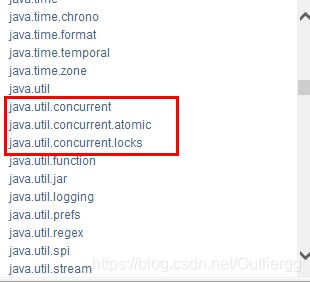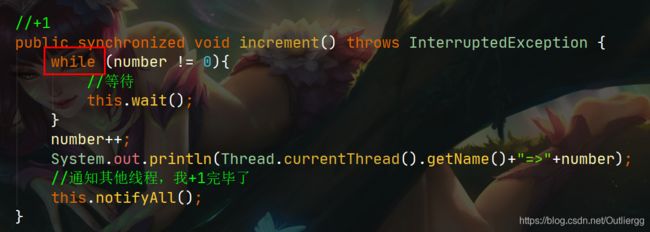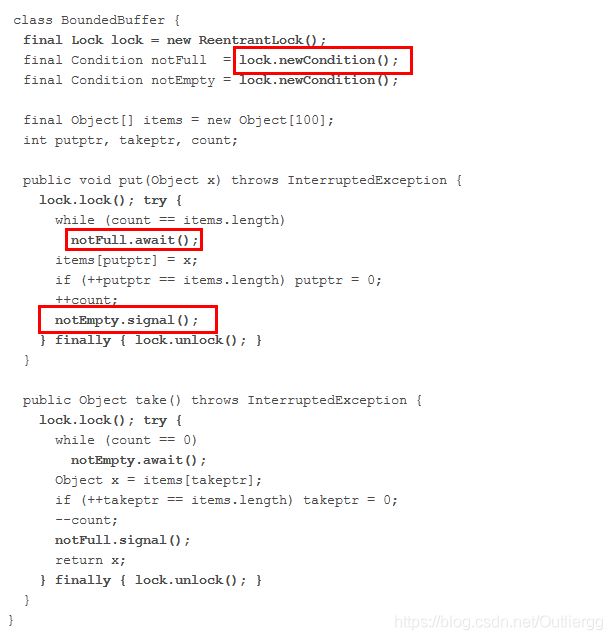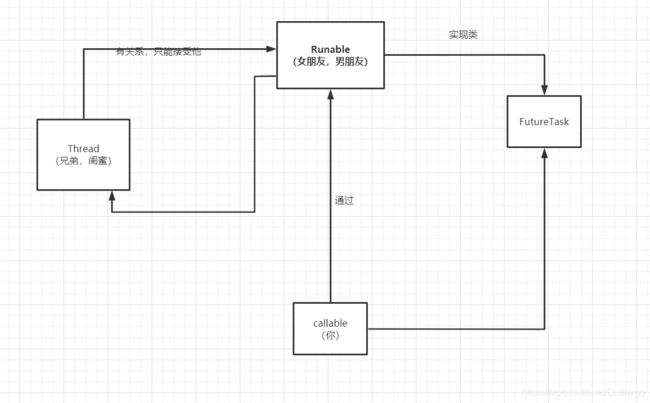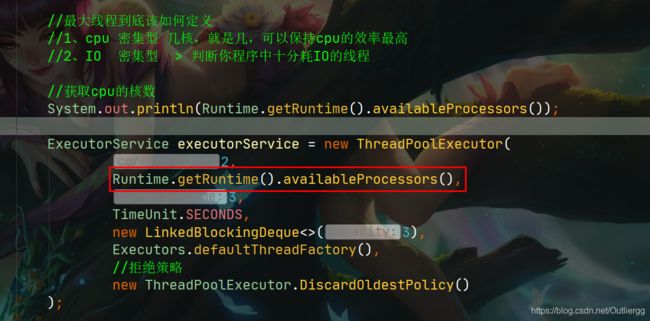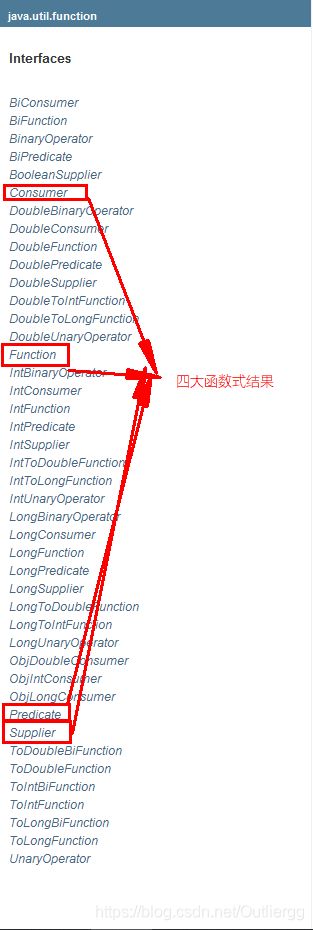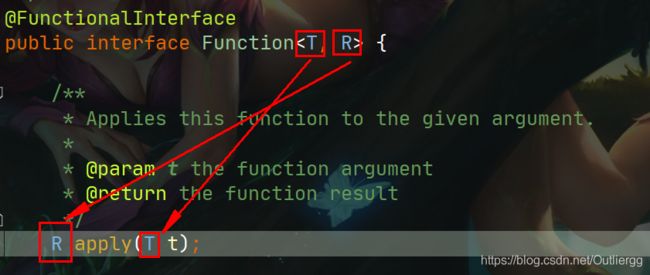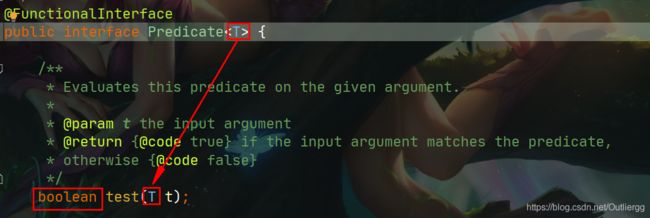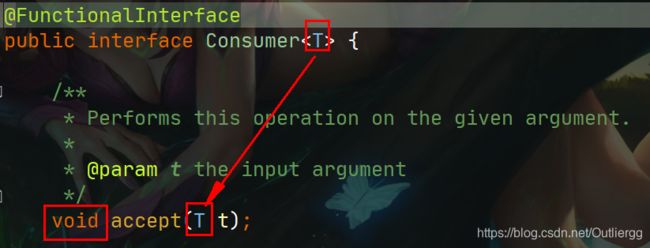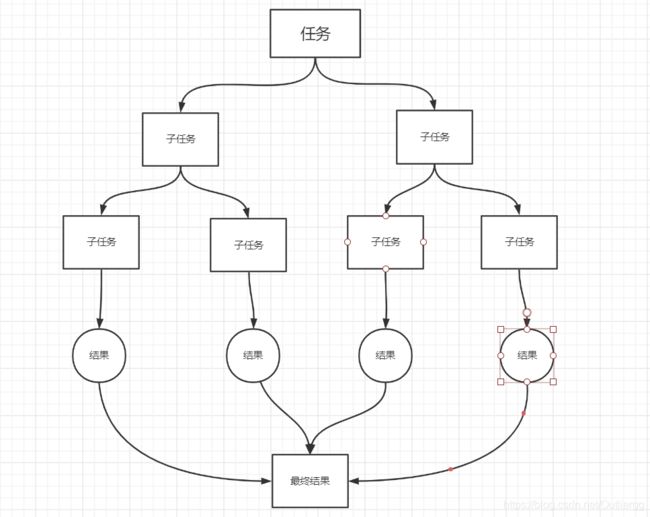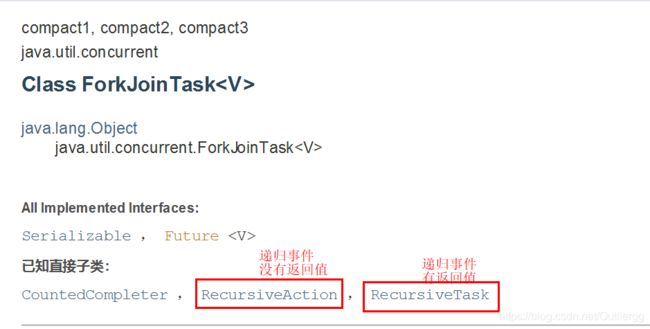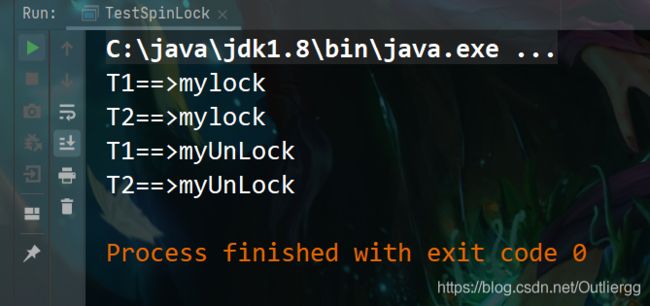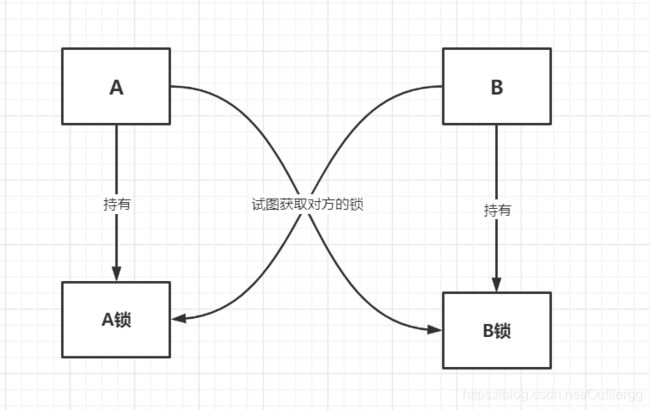JUC并发编程(多线程进阶)
目录
- 1、什么是JUC
- 2、线程和进程
- 3、Lock锁(重点)
- 4、生产者和消费者的问题
- 5、Condition
- 6、八锁现象
- 7、集合类不安全
- 8、Callable
- 9、常用的辅助类
- 9.1、CountDownLatch
- 9.2、CyclicBarrier
- 9.3、Semaphore
- 10、读写锁
- 11、阻塞队列
- 11.1、四组API
- 11.2、SynchronousQueue 同步队列
- 12、 线程池
- 13、四大函数式接口
- 14、Stream流式计算
- 15、ForkJoin
- 16、异步回调
- 17、JMM
- 18、volatile
- 19、单例模式
- 20、深入理解CAS
- 21、原子引用
- 22、各种锁的理解
- 22.1、公平锁、非公平锁
- 22.2、可重入锁
- 22.3、自旋锁
- 22.4、死锁
1、什么是JUC
Runnable没有返回值,效率相比于Callable相对较低
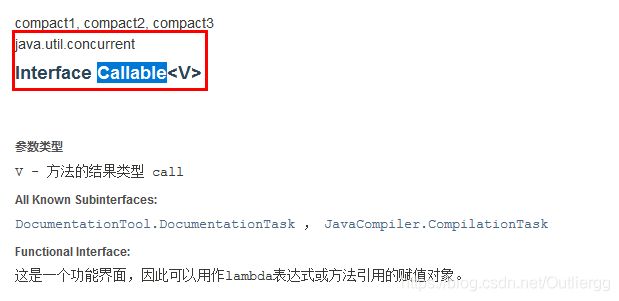
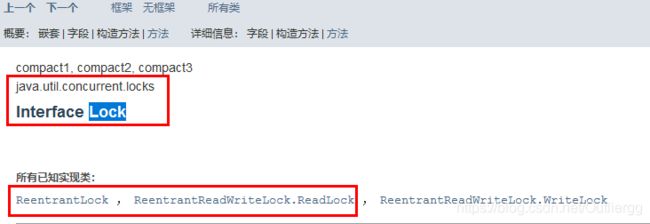
2、线程和进程
- 进程:一个程序的集合。
- 一个进程至少包含多个线程,至少包含一个。
- java默认有2个线程。
- java开启不了进程
public synchronized void start() {
/**
* This method is not invoked for the main method thread or "system"
* group threads created/set up by the VM. Any new functionality added
* to this method in the future may have to also be added to the VM.
*
* A zero status value corresponds to state "NEW".
*/
if (threadStatus != 0)
throw new IllegalThreadStateException();
/* Notify the group that this thread is about to be started
* so that it can be added to the group's list of threads
* and the group's unstarted count can be decremented. */
group.add(this);
boolean started = false;
try {
start0();
started = true;
} finally {
try {
if (!started) {
group.threadStartFailed(this);
}
} catch (Throwable ignore) {
/* do nothing. If start0 threw a Throwable then
it will be passed up the call stack */
}
}
}
//本地的方法,调用的是底层的c++,java无法直接操作硬件
private native void start0();
并行,并发
并发编程:并行,并发
并发:多个线程操作同一个资源。
- cpu一核,模拟出来多条线程,天下武功,为快不破,快速交替
并行:多个人一起行走
- cpu多核,多个线程可以同时执行
public class Test01 {
public static void main(String[] args) {
//获取cpu的核数
//cpu密集型,IO密集型
System.out.println(Runtime.getRuntime().availableProcessors());
}
}
并发编程的本质:充分利用cpu的资源
线程有几个状态
public enum State {
//新生
NEW,
//运行
RUNNABLE,
//阻塞
BLOCKED,
//等待,死死的等待
WAITING,
//超时等待
TIMED_WAITING,
//终止
TERMINATED;
}
wait/sleep区别
1、来自不同的类
wait =》object
sleep =》Thread
2、关于锁的释放
wait会释放锁;sleep睡觉了,抱着锁睡,不会释放。
3、使用的范围是不同的
- wait:必须在同步代码块中
- sleep:可以在任何地方使用。
4、是否需要捕获异常
- wait一般是不需要捕获异常,但可能会存在中断异常。
- sleep必须要捕获异常
3、Lock锁(重点)
传统的synchronized方式
public class SaleTicketDemo1 {
public static void main(String[] args) {
//并发:多线程操作同一个资源类,把资源类丢入线程
final Ticket ticket = new Ticket();
new Thread(()->{
for (int i = 0; i < 60; i++) {
ticket.sale();
}
},"A").start();
new Thread(()->{
for (int i = 0; i < 60; i++) {
ticket.sale();
}
},"B").start();
new Thread(()->{
for (int i = 0; i < 60; i++) {
ticket.sale();
}
},"C").start();
}
}
//资源类oop
class Ticket{
//属性,方法
private int number = 50;
//卖票的方式
//synchronized的本质:对列,锁
public synchronized void sale(){
if (number>0){
System.out.println(Thread.currentThread().getName()+"卖出了"+(number--)+"票,剩余:"+number);
}
}
}
Lock接口

公平锁:十分公平,可以先来后到。
非公平锁:十分不公平,可以插队。(默认)
public class SaleTicketDemo2 {
public static void main(String[] args) {
//并发:多线程操作同一个资源类,把资源类丢入线程
Ticket2 ticket = new Ticket2();
new Thread(()->{
for (int i = 0; i < 60; i++) {
ticket.sale();
}
},"A").start();
new Thread(()->{
for (int i = 0; i < 60; i++) {
ticket.sale();
}
},"B").start();
new Thread(()->{
for (int i = 0; i < 60; i++) {
ticket.sale();
}
},"C").start();
}
}
//资源类oop
class Ticket2{
//属性,方法
private int number = 50;
Lock lock = new ReentrantLock();
public void sale(){
lock.lock();//加锁
//业务代码
try {
if (number>0){
System.out.println(Thread.currentThread().getName()+"卖出了"+(number--)+"票,剩余:"+number);
}
} catch (Exception e) {
e.printStackTrace();
} finally {
lock.unlock();//解锁
}
}
}
synchronized 和 lock区别
- 1、synchronized 是内置的java关键字,lock是一个java类
- 2、synchronized 无法判断获取锁的状态,lock可以判断是否获取到了锁
- 3、synchronized 会自动释放锁;lock必须要手动释放锁,如果不释放锁,就会造成死锁
- 4、synchronized 线程1(获得锁,阻塞)、线程2(等待,傻傻的等);lock锁就不一定会等待下去。
- 5、synchronized 可重入锁,不可以中断的,非公平;lock也是可重入锁,可以判断锁,非公平(可以自己设置);
- 6、 synchronized 适合锁少量的代码同步问题,lock适合锁大量的同步代码。
锁是什么,如何判断锁的是谁!
4、生产者和消费者的问题
生产者和消费者问题Synchronized版
package com.slime.pc;
public class A {
public static void main(String[] args) {
Data data = new Data();
new Thread(()->{
for (int i = 0; i < 10; i++) {
try {
data.increment();
} catch (InterruptedException e) {
e.printStackTrace();
}
}
},"A").start();
new Thread(()->{
for (int i = 0; i < 10; i++) {
try {
data.decrement();
} catch (InterruptedException e) {
e.printStackTrace();
}
}
},"B").start();
}
}
class Data{
private int number = 0;
//+1
public synchronized void increment() throws InterruptedException {
if (number != 0){
//等待
this.wait();
}
number++;
System.out.println(Thread.currentThread().getName()+"=>"+number);
//通知其他线程,我+1完毕了
this.notifyAll();
}
//-1
public synchronized void decrement() throws InterruptedException {
if (number == 0){
//等待
this.wait();
}
number--;
System.out.println(Thread.currentThread().getName()+"=>"+number);
//通知其他线程,我-1完毕了
this.notifyAll();
}
}
思考:两个线程没有什么问题,那多个线程是否会出现问题呢?
增加两个线程后测试,结果明显出错了。
怎么解决虚假唤醒?
if 改为 while 判断
JUC版的生产者和消费者的问题
package com.slime.pc;
import java.util.concurrent.locks.Condition;
import java.util.concurrent.locks.Lock;
import java.util.concurrent.locks.ReentrantLock;
public class B {
public static void main(String[] args) {
Data2 data = new Data2();
new Thread(()->{
for (int i = 0; i < 10; i++) {
try {
data.increment();
} catch (InterruptedException e) {
e.printStackTrace();
}
}
},"A").start();
new Thread(()->{
for (int i = 0; i < 10; i++) {
try {
data.decrement();
} catch (InterruptedException e) {
e.printStackTrace();
}
}
},"B").start();
new Thread(()->{
for (int i = 0; i < 10; i++) {
try {
data.decrement();
} catch (InterruptedException e) {
e.printStackTrace();
}
}
},"C").start();
new Thread(()->{
for (int i = 0; i < 10; i++) {
try {
data.increment();
} catch (InterruptedException e) {
e.printStackTrace();
}
}
},"D").start();
}
}
class Data2{
private int number = 0;
Lock lock = new ReentrantLock();
Condition condition = lock.newCondition();
//+1
public void increment() throws InterruptedException {
lock.lock();
try {
while (number != 0){
//等待
condition.await();
}
number++;
System.out.println(Thread.currentThread().getName()+"=>"+number);
//通知其他线程,我+1完毕了
condition.signalAll();
} catch (Exception e) {
e.printStackTrace();
} finally {
lock.unlock();
}
}
//-1
public void decrement() throws InterruptedException {
lock.lock();
try {
while (number == 0) {
//等待
condition.await();
}
number--;
System.out.println(Thread.currentThread().getName() + "=>" + number);
//通知其他线程,我-1完毕了
condition.signalAll();
} catch (Exception e) {
e.printStackTrace();
} finally {
lock.unlock();
}
}
}
问题:现在线程执行出来的结果是随机实现的,我们想要控制线程有序执行该怎么做呢?
5、Condition
1、Condition是什么?
精准的通知和唤醒线程
2、 代码实现
package com.slime.pc;
import java.util.concurrent.locks.Condition;
import java.util.concurrent.locks.Lock;
import java.util.concurrent.locks.ReentrantLock;
public class C {
public static void main(String[] args) {
Data3 data = new Data3();
new Thread(()->{
for (int i = 0; i < 10; i++) {
data.printA();
}
},"A").start();
new Thread(()->{
for (int i = 0; i < 10; i++) {
data.printB();
}
},"B").start();
new Thread(()->{
for (int i = 0; i < 10; i++) {
data.printC();
}
},"C").start();
}
}
class Data3{
private Lock lock = new ReentrantLock();
private Condition condition1 = lock.newCondition();
private Condition condition2 = lock.newCondition();
private Condition condition3 = lock.newCondition();
private int number = 1;
public void printA(){
lock.lock();
try {
while (number != 1){
condition1.await();
}
System.out.println(Thread.currentThread().getName()+"=>AAAAAA");
//唤醒,唤醒指定的人,B
number = 2;
condition2.signal();
} catch (InterruptedException e) {
e.printStackTrace();
} finally {
lock.unlock();
}
}
public void printB(){
lock.lock();
try {
while (number != 2){
condition2.await();
}
System.out.println(Thread.currentThread().getName()+"=>BBBBBB");
//唤醒,唤醒指定的人,B
number = 3;
condition3.signal();
} catch (InterruptedException e) {
e.printStackTrace();
} finally {
lock.unlock();
}
}
public void printC(){
lock.lock();
try {
while (number != 3){
condition3.await();
}
System.out.println(Thread.currentThread().getName()+"=>CCCCCC");
//唤醒,唤醒指定的人,B
number = 1;
condition1.signal();
} catch (InterruptedException e) {
e.printStackTrace();
} finally {
lock.unlock();
}
}
}
6、八锁现象
四个案例详解
1、
package com.slime.lock8;
import java.util.concurrent.TimeUnit;
//问题:先打印出来发短信还是打电话?
public class Test1 {
public static void main(String[] args) {
Phone phone = new Phone();
//不是先调用了发短信的方法的原因,而是锁的问题
new Thread(()->{
phone.sendms();
},"A").start();
new Thread(()->{
phone.call();
},"B").start();
}
}
//synchronized锁的对象是方法的调用者
//这里只有一把锁,两个方法用的都是这把锁,所以谁先拿到谁执行。
class Phone{
public synchronized void sendms(){
try {
TimeUnit.SECONDS.sleep(4);
} catch (InterruptedException e) {
e.printStackTrace();
}
System.out.println("发短信");
}
public synchronized void call(){
System.out.println("打电话");
}
}
2、
package com.slime.lock8;
import java.util.concurrent.TimeUnit;
//增加了一个普通方法hello,现在是先执行发短信还是hello
public class Test2 {
public static void main(String[] args) {
//两个对象,两个调用者,两把锁,
Phone2 phone = new Phone2();
Phone2 phone2 = new Phone2();
//不是先调用了发短信的方法的原因,而是锁的问题
new Thread(()->{
phone.sendms();
},"A").start();
new Thread(()->{
phone2.call();
},"B").start();
}
}
class Phone2{
public synchronized void sendms(){
try {
TimeUnit.SECONDS.sleep(4);
} catch (InterruptedException e) {
e.printStackTrace();
}
System.out.println("发短信");
}
public synchronized void call(){
System.out.println("打电话");
}
//这里没有锁,不是同步方法。不受锁的影响
public void hello(){
System.out.println("Hello");
}
}
3、
package com.slime.lock8;
import java.util.concurrent.TimeUnit;
//增加两个静态的同步方法,只有一个对象,先打印发短信还是打电话
public class Test3 {
public static void main(String[] args) {
//两个对象的class类模板只有一个,static,锁的是class
Phone3 phone = new Phone3();
Phone3 phone2 = new Phone3();
//锁的存在
new Thread(()->{
phone.sendms();
},"A").start();
new Thread(()->{
phone2.call();
},"B").start();
}
}
//Phone3唯一的一个class对象
class Phone3{
//synchronized锁的对象是方法的调用者
//static静态方法
//类一加载就有了,锁的是class
public static synchronized void sendms(){
try {
TimeUnit.SECONDS.sleep(4);
} catch (InterruptedException e) {
e.printStackTrace();
}
System.out.println("发短信");
}
public static synchronized void call(){
System.out.println("打电话");
}
}
4、
package com.slime.lock8;
import java.util.concurrent.TimeUnit;
//1个静态的同步方法,1个普通的同步方法,一个对象,先打印发短信还是打电话
public class Test4 {
public static void main(String[] args) {
//两个对象的class类模板只有一个,static,锁的是class
Phone4 phone = new Phone4();
Phone4 phone2 = new Phone4();
//锁的存在
new Thread(()->{
phone.sendms();
},"A").start();
new Thread(()->{
phone2.call();
},"B").start();
}
}
//Phone3唯一的一个class对象
class Phone4{
//静态的同步方法,锁的是class类模板
public static synchronized void sendms(){
try {
TimeUnit.SECONDS.sleep(4);
} catch (InterruptedException e) {
e.printStackTrace();
}
System.out.println("发短信");
}
//普通的同步方法
public synchronized void call(){
System.out.println("打电话");
}
}
小结
- 如果只有一把锁,两个方法都使用这把相同的锁,那么谁先拿到谁先执行(案例一)
- 如果有一个方法没有上锁,那么就不受锁的影响,会先执行这个方法。(案例二)
- 如果两个加锁的方法都是用static修饰的静态方法,那么还是会依次执行(案例三)
- 如果两个加锁的方法一个是静态的同步方法,一个是普通的同步方法,并且静态的同步方法加上了延迟,那么就会先执行普通的同步方法。
7、集合类不安全
List不安全
//java.util.ConcurrentModificationException : 并发修改异常
public class ListTest {
public static void main(String[] args) {
//并发下ArrayList不安全的
/*
* 解决方案:
* 1、List list = new Vector<>();
* 2、List list = Collections.synchronizedList(new ArrayList<>());
* 3、List list = new CopyOnWriteArrayList<>();
*/
//CopyOnWrite写入时复制
List<String> list = new CopyOnWriteArrayList<>();
for (int i = 1; i < 10; i++) {
new Thread(()->{
list.add(UUID.randomUUID().toString().substring(0,5));
System.out.println(list);
},String.valueOf(i)).start();
}
}
}
set不安全
public class setTest {
public static void main(String[] args) {
/*
* 同理可证:java.util.ConcurrentModificationException
* 解决方案:
* 1、Set set = Collections.synchronizedSet(new HashSet<>());
* 2、Set set = new CopyOnWriteArraySet<>();
*/
//Set set = new HashSet<>();
//Set set = Collections.synchronizedSet(new HashSet<>());
Set<String> set = new CopyOnWriteArraySet<>();
for (int i = 0; i < 30; i++) {
new Thread(()->{
set.add(UUID.randomUUID().toString().substring(0,5));
System.out.println(set);
},String.valueOf(i)).start();
}
}
}
HashSet底层是什么?
public HashSet() {
map = new HashMap<>();
}
//add set 的本质就是map key是无法重复的
public boolean add(E e) {
return map.put(e, PRESENT)==null;
}
Map不安全
public class MapTest {
public static void main(String[] args) {
//Mapmap = new ConcurrentHashMap<>();
Map<String , String>map = new ConcurrentHashMap<>();
for (int i = 1; i <= 30; i++) {
new Thread(()->{
map.put(Thread.currentThread().getName(), UUID.randomUUID().toString().substring(0,5));
System.out.println(map);
},String.valueOf(i)).start();
}
}
}
8、Callable
- 1、可以有返回值
- 2、可以抛出异常
- 3、方法不同,run()/ call()
public class CallableTest {
public static void main(String[] args) throws ExecutionException, InterruptedException {
new Thread().start();
MyThread thread = new MyThread();
FutureTask futureTask = new FutureTask(thread);//适配类
new Thread(futureTask,"A").start();
Integer o = (Integer) futureTask.get();
System.out.println(o);
}
}
class MyThread implements Callable<Integer>{
@Override
public Integer call() throws Exception {
System.out.println("call");
return 1024;
}
}
细节:
1、有缓存
2、结果可能需要等待,会阻塞
9、常用的辅助类
9.1、CountDownLatch
public class CountDownLatchDemo {
public static void main(String[] args) throws InterruptedException {
//总数是6,必须要执行任务的时候,再使用
CountDownLatch countDownLatch = new CountDownLatch(6);
for (int i = 1; i <= 6; i++) {
new Thread(()->{
System.out.println(Thread.currentThread().getName()+"Go out");
countDownLatch.countDown();//数量-1
},String.valueOf(i)).start();
}
countDownLatch.await(); //等待计数器归零,然后再向下执行
System.out.println("Close Door");
}
}
原理:
countDownLatch.countDown(); //数量-1
countDownLatch.await(); //等待计数器归零,然后再向下执行
每次有线程调用countDown()数量-1,假设计数器变为0,countDownLatch.await()就会被唤醒,继续执行!
9.2、CyclicBarrier
public class CyclicBarrierDemo {
public static void main(String[] args) {
//集齐七颗龙珠召唤神龙
//召唤龙珠的线程
CyclicBarrier cyclicBarrier = new CyclicBarrier(7,()->{
System.out.println("召唤神龙成功");
});
for (int i = 1; i <= 7; i++) {
final int temp = i;
//lambda能操作到i吗
new Thread(()->{
System.out.println(Thread.currentThread().getName()+"收集"+temp+"个龙珠");
try {
//等待
cyclicBarrier.await();
} catch (InterruptedException e) {
e.printStackTrace();
} catch (BrokenBarrierException e) {
e.printStackTrace();
}
}).start();
}
}
}
9.3、Semaphore
Semaphore:信号量
public class SemaphoreDemo {
public static void main(String[] args) {
//线程数量:停车位
Semaphore semaphore = new Semaphore(3);
for (int i = 1; i <= 6; i++) {
new Thread(()->{
//acquire()得到
try {
semaphore.acquire();
System.out.println(Thread.currentThread().getName()+"抢到车位");
TimeUnit.SECONDS.sleep(2);
System.out.println(Thread.currentThread().getName()+"离开车位");
} catch (InterruptedException e) {
e.printStackTrace();
}finally {
//release()释放
semaphore.release();
}
},String.valueOf(i)).start();
}
}
}
原理:
semaphore.acquire() :获得,假设如果已经满了,等待,等待被释放为止。
semaphore.release() :释放,会将当前的信号量释放+1,然后唤醒等待的线程。
作用:
1、多个共享资源互斥的使用。
2、并发限流,控制最大的线程数。
10、读写锁
public class ReadWriteLockDemo {
public static void main(String[] args) {
MyCacheLock myCache = new MyCacheLock();
//写入
for (int i = 1; i <= 5; i++) {
final int temp = i;
new Thread(()->{
myCache.put(temp+"",temp+"");
},String.valueOf(i)).start();
}
//读取
for (int i = 1; i <= 5; i++) {
final int temp = i;
new Thread(()->{
myCache.get(temp+"");
},String.valueOf(i)).start();
}
}
}
//自定义缓存
class MyCache{
private volatile Map<String,Object> map = new HashMap<>();
//存,写
public void put(String key,Object value){
System.out.println(Thread.currentThread().getName()+"写入"+key);
map.put(key,value);
System.out.println(Thread.currentThread().getName()+"写入OK");
}
//取,读
public void get(String key){
System.out.println(Thread.currentThread().getName()+"读取"+key);
Object o = map.get(key);
System.out.println(Thread.currentThread().getName()+"读取OK");
}
}
结果:

很明显,线程在执行的时候被其他线程随意的插入,这就造成了线程执行的混乱。
那怎么解决这个问题呢?(加锁)
public class ReadWriteLockDemo {
public static void main(String[] args) {
MyCacheLock myCache = new MyCacheLock();
//写入
for (int i = 1; i <= 5; i++) {
final int temp = i;
new Thread(()->{
myCache.put(temp+"",temp+"");
},String.valueOf(i)).start();
}
//读取
for (int i = 1; i <= 5; i++) {
final int temp = i;
new Thread(()->{
myCache.get(temp+"");
},String.valueOf(i)).start();
}
}
}
class MyCacheLock{
private volatile Map<String,Object> map = new HashMap<>();
//读写锁:更加细粒度的控制
private ReadWriteLock readWriteLock = new ReentrantReadWriteLock();
private Lock lock = new ReentrantLock();
//存,写入的时候,只希望同时只有一个线程写
public void put(String key,Object value){
readWriteLock.writeLock().lock();
try {
System.out.println(Thread.currentThread().getName()+"写入"+key);
map.put(key,value);
System.out.println(Thread.currentThread().getName()+"写入OK");
} catch (Exception e) {
e.printStackTrace();
} finally {
readWriteLock.writeLock().unlock();
}
}
//取,读
public void get(String key){
readWriteLock.readLock().lock();
try {
System.out.println(Thread.currentThread().getName()+"读取"+key);
Object o = map.get(key);
System.out.println(Thread.currentThread().getName()+"读取OK");
} catch (Exception e) {
e.printStackTrace();
} finally {
readWriteLock.readLock().unlock();
}
}
}
- 读-读 可以共存
- 读-写 不能共存
- 写-写 不能共存
- 独占锁(写锁) 一次只能被一个线程占有
- 共享锁(读锁) 多个线程可以同时占有
11、阻塞队列
写入:如果队列满了,就必须阻塞等待
取: 如果队列是空的,必须阻塞等待生产
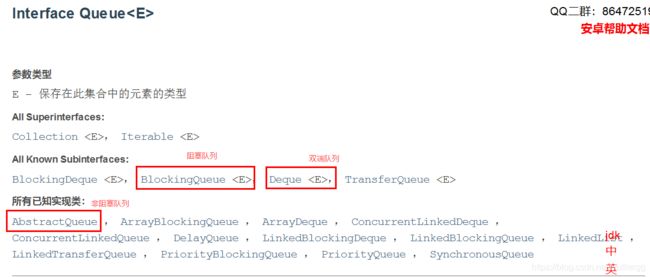
BlockingQueue:不是什么新的知识点
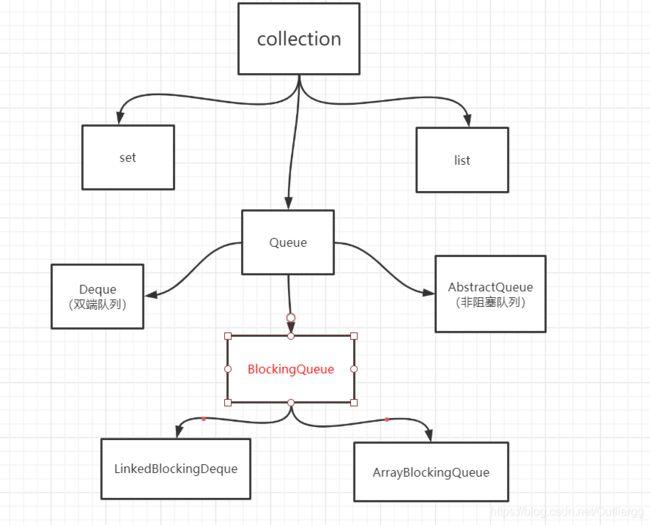
什么情况下我们会使用阻塞队列:多线程并发处理,线程池
11.1、四组API
1、抛出异常
- 添加:add
- 移除:remove
- 检测队首元素:element()
public class Test {
public static void main(String[] args) {
test1();
}
/*
* 功能描述:抛出异常
* @author:wzm
* @return:
* @date: 2020/5/31 14:04
*/
public static void test1(){
//队列的大小
ArrayBlockingQueue blockingQueue = new ArrayBlockingQueue<>(3);
System.out.println(blockingQueue.add("a"));
System.out.println(blockingQueue.add("b"));
System.out.println(blockingQueue.add("c"));
//java.lang.IllegalStateException: Queue full (队列已满)
//System.out.println(blockingQueue.add("d"));
//查看队首元素是谁
System.out.println(blockingQueue.element());
System.out.println("======================");
System.out.println(blockingQueue.remove());
System.out.println(blockingQueue.remove());
System.out.println(blockingQueue.remove());
//java.util.NoSuchElementException (队列已空,没有元素)
System.out.println(blockingQueue.remove());
}
}
2、有返回值,不会抛出异常
- 添加:offer
- 移除:poll
- 检测队首元素:peek()
public class Test {
public static void main(String[] args) {
test2();
}
/*
* 功能描述:有返回值,没有异常
* @author:wzm
* @return:
* @date: 2020/5/31 14:18
*/
public static void test2(){
//队列的大小
ArrayBlockingQueue blockingQueue = new ArrayBlockingQueue<>(3);
System.out.println(blockingQueue.offer("a"));
System.out.println(blockingQueue.offer("b"));
System.out.println(blockingQueue.offer("c"));
//false 不抛出异常
System.out.println(blockingQueue.offer("d"));
//查看队首元素是谁
System.out.println(blockingQueue.peek());
System.out.println("===========================");
System.out.println(blockingQueue.poll());
System.out.println(blockingQueue.poll());
System.out.println(blockingQueue.poll());
//null,不抛出异常
System.out.println(blockingQueue.poll());
}
}
3、阻塞等待
- put()
- take()
public class Test {
public static void main(String[] args) throws InterruptedException {
test3();
}
/*
* 功能描述:等待,阻塞
* @author:wzm
* @return:
* @date: 2020/5/31 14:30
*/
public static void test3() throws InterruptedException {
//队列的大小
ArrayBlockingQueue blockingQueue = new ArrayBlockingQueue<>(3);
//一直阻塞
blockingQueue.put("a");
blockingQueue.put("b");
blockingQueue.put("c");
//队列没有位置了,一直阻塞
//blockingQueue.put("d");
System.out.println(blockingQueue.take());
System.out.println(blockingQueue.take());
System.out.println(blockingQueue.take());
}
}
4、超时等待
- 添加:offer
- 移除:poll
public class Test {
public static void main(String[] args) throws InterruptedException {
test4();
}
/*
* 功能描述:等待,阻塞(等待超时)
* @author:wzm
* @return:
* @date: 2020/5/31 14:50
*/
public static void test4() throws InterruptedException {
//队列的大小
ArrayBlockingQueue blockingQueue = new ArrayBlockingQueue<>(3);
blockingQueue.offer("a");
blockingQueue.offer("b");
blockingQueue.offer("c");
//等待超过2秒就退出
//blockingQueue.offer("d",2, TimeUnit.SECONDS);
System.out.println("=================");
System.out.println(blockingQueue.poll());
System.out.println(blockingQueue.poll());
System.out.println(blockingQueue.poll());
//等待超过2秒就退出
blockingQueue.poll(2,TimeUnit.SECONDS);
}
}
11.2、SynchronousQueue 同步队列
/*
* 功能描述:同步队列
* @author:wzm
* @return:
* @date: 2020/5/31 15:08
*/
public class SynchronousQueueDemo {
public static void main(String[] args) {
//同步队列
SynchronousQueue<String> synchronousQueue = new SynchronousQueue<>();
new Thread(()->{
try {
System.out.println(Thread.currentThread().getName()+"put 1");
synchronousQueue.put("1");
System.out.println(Thread.currentThread().getName()+"put 2");
synchronousQueue.put("2");
System.out.println(Thread.currentThread().getName()+"put 3");
synchronousQueue.put("3");
} catch (Exception e) {
e.printStackTrace();
}
},"T1").start();
new Thread(()->{
try {
TimeUnit.SECONDS.sleep(3);
System.out.println(Thread.currentThread().getName()+"=>"+synchronousQueue.take());
TimeUnit.SECONDS.sleep(3);
System.out.println(Thread.currentThread().getName()+"=>"+synchronousQueue.take());
TimeUnit.SECONDS.sleep(3);
System.out.println(Thread.currentThread().getName()+"=>"+synchronousQueue.take());
} catch (InterruptedException e) {
e.printStackTrace();
}
},"T2").start();
}
}
12、 线程池
线程池:三大方法,7大参数,4种拒绝策略
池化技术
程序的运行、本质:占用系统的资源!优化资源的使用 => 池化技术
池化技术:事先准备好一些资源,有人要用,就来我这里拿,用完之后还给我。
线程池的好处:
1、降低资源的消耗
2、提高响应的速度
3、方便管理
线程复用、可以控制最大并发数、管理线程
线程池:三大方法
//Executors 工具类、3大方法
public class Demo1 {
public static void main(String[] args) {
//ExecutorService executorService = Executors.newSingleThreadExecutor();//单个线程
//ExecutorService executorService = Executors.newFixedThreadPool(5);//创建一个固定的线程池的大小
ExecutorService executorService = Executors.newCachedThreadPool();//可伸缩的,遇强则强,遇弱则弱
try {
for (int i = 0; i < 10; i++) {
//使用了线程池之后,使用线程池来创建线程
executorService.execute(()->{
System.out.println(Thread.currentThread().getName()+" OK");
});
}
} catch (Exception e) {
e.printStackTrace();
} finally {
//线程池用完,程序结束,关闭线程池
executorService.shutdown();
}
}
}
7大参数,四种拒绝策略
public class Demo1 {
public static void main(String[] args) {
//ExecutorService executorService = Executors.newSingleThreadExecutor();//单个线程
//ExecutorService executorService = Executors.newFixedThreadPool(5);//创建一个固定的线程池的大小
//ExecutorService executorService = Executors.newCachedThreadPool();//可伸缩的,遇强则强,遇弱则弱
ExecutorService executorService = new ThreadPoolExecutor(
2,
5,
3,
TimeUnit.SECONDS,
new LinkedBlockingDeque<>(3),
Executors.defaultThreadFactory(),
//拒绝策略
new ThreadPoolExecutor.DiscardOldestPolicy()
);
try {
for (int i = 0; i < 9; i++) {
//使用了线程池之后,使用线程池来创建线程
executorService.execute(()->{
System.out.println(Thread.currentThread().getName()+" OK");
});
}
} catch (Exception e) {
e.printStackTrace();
} finally {
//线程池用完,程序结束,关闭线程池
executorService.shutdown();
}
}
}
new ThreadPoolExecutor.AbortPolicy() //线程池满了,还有线程进来,不处理这个线程,抛出异常
new ThreadPoolExecutor.CallerRunsPolicy() //哪里执行的线程回哪里去处理
new ThreadPoolExecutor.DiscardPolicy() //队列满了,丢掉这个任务,不会抛出异常
new ThreadPoolExecutor.DiscardOldestPolicy() //队列满了,尝试去和最早的执行线程竞争,如果竞争失败了依旧会丢掉这个线程,成功了就会执行这个线程
小结和拓展
了解:IO密集型,CPU密集型:(调优)
最大线程到底该如何定义
1、cpu 密集型 几核,就是几,可以保持cpu的效率最高
2、IO 密集型 > 判断你程序中十分耗IO的线程
13、四大函数式接口
函数式接口:只有一个方法的接口
@FunctionalInterface
public interface Runnable {
public abstract void run();
}
@FunctionalInterface在java程序中广泛存在
可以简化编程模型,在新版本的框架底层大量应用
foreach(消费者类的函数式接口)
public class Demo1 {
public static void main(String[] args) {
/*Function function = new Function() {
@Override
public String apply(String str) {
return str;
}
};*/
Function<String,String> function = (str)->{return str;};
System.out.println(function.apply("asd"));
}
}
Predicate (断定型接口):有一个输入参数,返回值只能是布尔值
public class Demo2 {
public static void main(String[] args) {
//判断字符串是否为空
/*Predicatepredicate = new Predicate() {
@Override
public boolean test(String s) {
return s.isEmpty();
}
};*/
Predicate<String>predicate = (s)->{return s.isEmpty();};
System.out.println(predicate.test(""));
}
}
Consumer (消费型接口):只有输入,没有返回值
public class Demo3 {
public static void main(String[] args) {
/*Consumer consumer = new Consumer() {
@Override
public void accept(String s) {
System.out.println(s);
}
};*/
Consumer<String> consumer = (s)->{
System.out.println(s);
};
consumer.accept("一叶孤舟");
}
}
Supplier(供给型接口):没有参数,只有返回值
public class Demo4 {
public static void main(String[] args) {
/*Supplier supplier = new Supplier() {
@Override
public Integer get() {
return 1024;
}
};*/
Supplier supplier = ()->{return 1024;};
System.out.println(supplier.get());
}
}
14、Stream流式计算
@Data
@NoArgsConstructor
@AllArgsConstructor
public class User {
private int id;
private String name;
private int age;
}
2、测试类
/*
* 现在有5个用户,筛选:
* 1、ID必须是偶数
* 2、年龄必须大于23岁
* 3、用户名转为大写字母
* 4、用户名字母倒着排序
* 5、只输出一个用户
*/
public class Test {
public static void main(String[] args) {
User u1 = new User(1,"a",21);
User u2 = new User(2,"b",22);
User u3 = new User(3,"c",23);
User u4 = new User(4,"d",24);
User u5 = new User(5,"e",25);
//集合就是存储
List<User> list = Arrays.asList(u1,u2,u3,u4,u5);
//计算交给Stream流
//链式编程
list.stream()
.filter(u->{return u.getId()%2 == 0;})
.filter(u->{return u.getAge()>23;})
.map(u->{return u.getName().toUpperCase();})
.sorted((uu1,uu2)->{return uu2.compareTo(uu1);})
.limit(1)
.forEach(System.out::println);
}
}
15、ForkJoin
什么是ForkJoin
ForkJoin在JDK1.7中添加,用处是并行执行任务,提高效率,
ForkJoin的特点:工作窃取
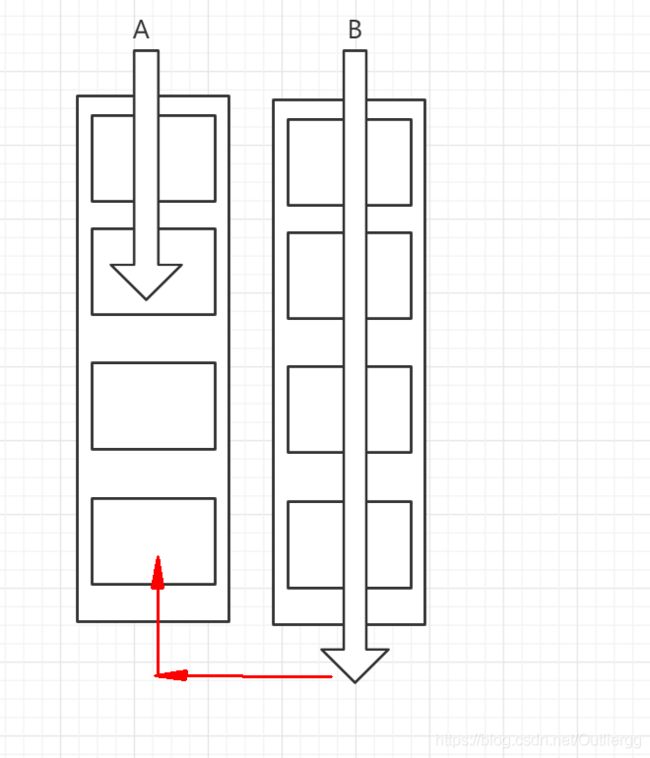
当B线程执行完了之后,A线程还没执行完;B线程就会去执行A线程没有执行完的部分,这就是工作窃取。
public class ForkJoinDemo extends RecursiveTask<Long> {
private Long start;
private Long end;
//临界值
private Long temp = 10000L;
public ForkJoinDemo(Long start, Long end) {
this.start = start;
this.end = end;
}
//计算方法
@Override
protected Long compute() {
if ((end - start) < temp) {
Long sum = 0L;
for (Long i = start;i <= end;i++){
sum += i;
}
return sum;
} else {
long middle = (start + end) / 2;
ForkJoinDemo task1 = new ForkJoinDemo(start,middle);
task1.fork(); //拆分任务,把任务压入线程队列
ForkJoinDemo task2 = new ForkJoinDemo(middle+1,end);
task2.fork(); //拆分任务,把任务压入线程队列
return task1.join() + task2.join();
}
}
}
测试类:
package com.slime.forkjoin;
import java.util.concurrent.ExecutionException;
import java.util.concurrent.ForkJoinPool;
import java.util.concurrent.ForkJoinTask;
import java.util.stream.LongStream;
public class Test {
public static void main(String[] args) throws ExecutionException, InterruptedException {
//test1();
//test2();
test3();
}
//普通程序员
public static void test1(){
Long sum = 0L;
long start = System.currentTimeMillis();
for (Long i = 1L; i < 10_0000_0000; i++) {
sum += i;
}
long end = System.currentTimeMillis();
System.out.println("sum="+sum+"时间:"+(end-start));
}
public static void test2() throws ExecutionException, InterruptedException {
long start = System.currentTimeMillis();
ForkJoinPool forkJoinPool = new ForkJoinPool();
ForkJoinTask<Long> task = new ForkJoinDemo(0L, (long) 10_0000_0000);
ForkJoinTask<Long> submit = forkJoinPool.submit(task);//提交任务
Long sum = submit.get();
long end = System.currentTimeMillis();
System.out.println("sum="+sum+"时间:"+(end-start));
}
public static void test3(){
long start = System.currentTimeMillis();
//Stream并行流()
long sum = LongStream.rangeClosed(0L,10_0000_0000).parallel().reduce(0,Long::sum);
long end = System.currentTimeMillis();
System.out.println("sum="+"时间:"+(end-start));
}
}
16、异步回调
Future设计的初衷:对将来的某个事情的结果进行建模
package com.slime.future;
import java.util.concurrent.CompletableFuture;
import java.util.concurrent.ExecutionException;
import java.util.concurrent.TimeUnit;
public class Demo1 {
public static void main(String[] args) throws ExecutionException, InterruptedException {
/*//没有返回值的runAsync异步回调
CompletableFuture completableFuture = CompletableFuture.runAsync(()->{
try {
TimeUnit.SECONDS.sleep(2);
} catch (InterruptedException e) {
e.printStackTrace();
}
System.out.println(Thread.currentThread().getName()+"runAsync=>Void");
});
System.out.println("111");
//获取阻塞执行结果
completableFuture.get();*/
//有返回值的runAsync异步回调
CompletableFuture<Integer> completableFuture = CompletableFuture.supplyAsync(()->{
System.out.println(Thread.currentThread().getName()+"supplyAsync=>Integer");
return 1024;
});
System.out.println(completableFuture.whenComplete((t,u)->{
System.out.println("t=>"+t); //正常的返回结果
System.out.println("u=>"+u); //错误的信息
}).exceptionally((e)->{
System.out.println(e.getMessage());
return 233; //可以获取到错误的返回结果
}).get());
}
}
17、JMM
请你谈谈你对Volatile的理解
Volatile是java虚拟机提供的轻量级的同步机制
好处:
- 1、保证可见性
- 2、不保证原子性
- 3、禁止指令重排
什么是JMM
JMM:java内存模型,不存在的东西,概念,约定
关于JMM的一些同步的约定:
1、线程解锁前,必须把共享变量立刻刷回主存
2、线程加锁前,必须读取主存中的最新值到工作内存中
3、加锁和解锁是同一把锁
线程工作内存、主内存
8种操作:
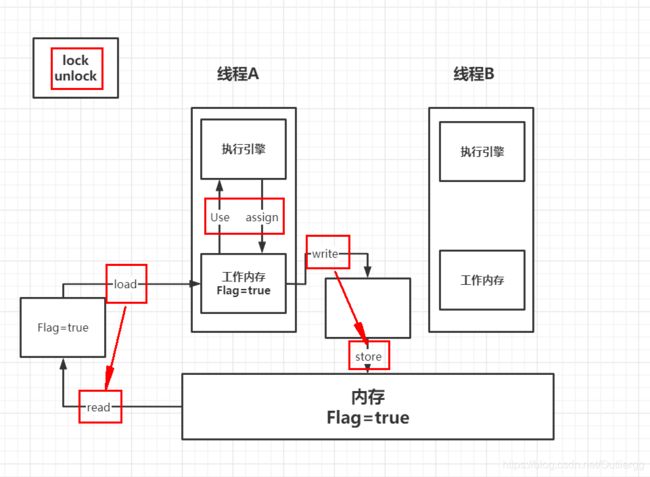
问题:线程B修改了值,但是线程A不能及时可见
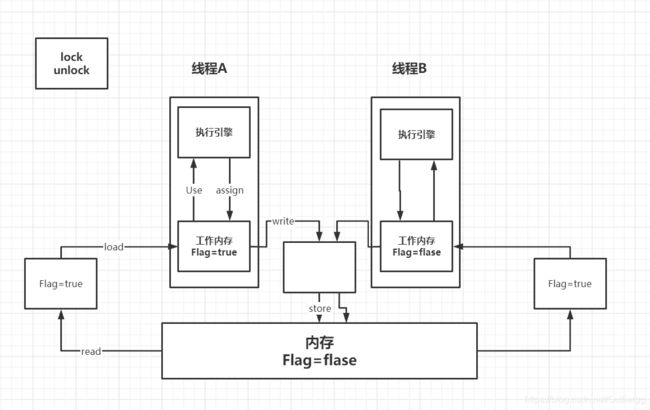
内存交互操作:
内存交互操作有8种,虚拟机实现必须保证每一个操作都是原子的,不可在分的(对于double和long类型的变量来说,load、store、read和write操作在某些平台上允许例外)
- lock (锁定):作用于主内存的变量,把一个变量标识为线程独占状态
- unlock (解锁):作用于主内存的变量,它把一个处于锁定状态的变量释放出来,释放后的变量才可以被其他线程锁定
- read (读取):作用于主内存变量,它把一个变量的值从主内存传输到线程的工作内存中,以便随后的load动作使用
- load (载入):作用于工作内存的变量,它把read操作从主存中变量放入工作内存中
- use (使用):作用于工作内存中的变量,它把工作内存中的变量传输给执行引擎,每当虚拟机遇到一个需要使用到变量的值,就会使用到这个指令
- assign (赋值):作用于工作内存中的变量,它把一个从执行引擎中接受到的值放入工作内存的变量副本中
- store (存储):作用于主内存中的变量,它把一个从工作内存中一个变量的值传送到主内存中,以便后续的write使用
- write (写入):作用于主内存中的变量,它把store操作从工作内存中得到的变量的值放入主内存的变量中
JMM对这八种指令的使用,制定了如下规则:
- 不允许read和load、store和write操作之一单独出现。即使用了read必须load,使用了store必须write
- 不允许线程丢弃他最近的assign操作,即工作变量的数据改变了之后,必须告知主存
- 不允许一个线程将没有assign的数据从工作内存同步回主内存
- 一个新的变量必须在主内存中诞生,不允许工作内存直接使用一个未被初始化的变量。就是怼变量实施use、store操作之前,必须经过assign和load操作
- 一个变量同一时间只有一个线程能对其进行lock。多次lock后,必须执行相同次数的unlock才能解锁
- 如果对一个变量进行lock操作,会清空所有工作内存中此变量的值,在执行引擎使用这个变量前,必须重新load或assign操作初始化变量的值
- 如果一个变量没有被lock,就不能对其进行unlock操作。也不能unlock一个被其他线程锁住的变量
- 对一个变量进行unlock操作之前,必须把此变量同步回主内存
代码测试:
public class JMMDemo {
private static int num = 0;
public static void main(String[] args) {
new Thread(()->{
while (num == 0){
}
}).start();
try {
TimeUnit.SECONDS.sleep(1);
} catch (InterruptedException e) {
e.printStackTrace();
}
num = 1;
System.out.println(num);
}
}
结果:
程序会陷入死循环,原因是主存不知道线程修改了值。
18、volatile
1、保证可见性
public class JMMDemo {
//不加volatile程序就会死循环
private volatile static int num = 0;
public static void main(String[] args) {
new Thread(()->{
while (num == 0){
}
}).start();
try {
TimeUnit.SECONDS.sleep(1);
} catch (InterruptedException e) {
e.printStackTrace();
}
num = 1;
System.out.println(num);
}
}
2、不保证原子性
原子性:不可分割
线程A在执行任务的时候,不能被打扰的,也不能被分割。要么同时成功,要么同时失败。
//volatile 不保证原子性
public class VDemo02 {
private volatile static int num = 0;
public static void add(){
num++;
}
public static void main(String[] args) {
//理论上num结果应该为2万
for (int i = 0; i < 20; i++) {
new Thread(()->{
for (int j = 0; j < 1000; j++) {
add();
}
}).start();
}
while (Thread.activeCount()>2){
Thread.yield();
}
System.out.println(Thread.currentThread().getName()+" "+num);
}
}
如果不加lock和synchronized,怎么样保证原子性

//volatile 不保证原子性
public class VDemo02 {
//volatile 不保证原子性
//原子类的Integer
private volatile static AtomicInteger num = new AtomicInteger();
public static void add(){
//num++; //不是一个原子性操作
num.getAndIncrement();
}
public static void main(String[] args) {
//理论上num结果应该为2万
for (int i = 0; i < 20; i++) {
new Thread(()->{
for (int j = 0; j < 1000; j++) {
add();
}
}).start();
}
while (Thread.activeCount()>2){
Thread.yield();
}
System.out.println(Thread.currentThread().getName()+" "+num);
}
}
这些类的底层都直接和操作系统挂钩!在内存中修改值!Unsafe类是一个很特殊的存在。
指令重排
什么是指令重排:你写的程序,计算机并不是按照你写的那样去执行的。
源代码–》编译器优化的重排–》指令并行也可能重排–》内存系统也会重排–》执行
处理器在进行指令重排的时候,要考虑一下数据之间的依赖性
volatile 可以避免指令重排
内存屏障,CPU指令。作用:
1、保证特定的操作的执行顺序!
2、可以保证某些变量的内存可见性(利用这些特性volatile 实现了可见性)

volatile 是可以保证可见性。不能保证原子性,由于内存屏障,可以保证避免指令重排的现象产生
问:内存屏障在哪个地方使用的最多?
单例模式
19、单例模式
饿汉式
//饿汉式单例
public class Hungry {
//可能会浪费空间
private byte[] data1 = new byte[1024*1024];
private byte[] data2 = new byte[1024*1024];
private byte[] data3 = new byte[1024*1024];
private byte[] data4 = new byte[1024*1024];
private Hungry(){
}
private final static Hungry HUNGRY = new Hungry();
public static Hungry getInstance(){
return HUNGRY;
}
}
DCL懒汉式
package com.slime.single;
import java.lang.reflect.Constructor;
import java.lang.reflect.Field;
public class LazyMan {
private static boolean hanhan = false;
private LazyMan(){
synchronized (LazyMan.class){
if (hanhan == false) {
hanhan = true;
}else {
throw new RuntimeException("不要试图使用反射破坏异常");
}
}
}
private static LazyMan lazyMan;
//双重检测锁模式的懒汉式单例,DCL懒汉式
public static LazyMan getInstance(){
if (lazyMan == null){
synchronized (LazyMan.class){
if (lazyMan == null){
lazyMan = new LazyMan();
}
}
}
return lazyMan;
}
//反射
public static void main(String[] args) throws Exception {
//LazyMan instance = LazyMan.getInstance();
Field hanhan = LazyMan.class.getDeclaredField("hanhan");
hanhan.setAccessible(true);
Constructor<LazyMan> declaredConstructor = LazyMan.class.getDeclaredConstructor(null);
declaredConstructor.setAccessible(true);
LazyMan instance = declaredConstructor.newInstance();
hanhan.set(instance,false);
LazyMan instance2 = declaredConstructor.newInstance();
System.out.println(instance);
System.out.println(instance2);
}
/*
* 1、分配内存空间
* 2、执行构造方法,初始化对象
* 3、把这个对象指向这个空间
*/
}
静态内部类
package com.slime.single;
//静态内部类
public class Holder {
private Holder(){
}
public static Holder getInstance(){
return InnerClass.HOLDER;
}
public static class InnerClass{
private static final Holder HOLDER = new Holder();
}
}
单例反射,不安全
枚举
package com.slime.single;
import java.lang.reflect.Constructor;
import java.lang.reflect.InvocationTargetException;
//enum是一个什么?本身也是一个Class类
public enum EnumSingle {
INSTANCE;
public EnumSingle getInstance(){
return INSTANCE;
}
}
class Test{
public static void main(String[] args) throws NoSuchMethodException, IllegalAccessException, InvocationTargetException, InstantiationException {
EnumSingle instance1 = EnumSingle.INSTANCE;
Constructor<EnumSingle> declaredConstructor = EnumSingle.class.getDeclaredConstructor(String.class,int.class);
declaredConstructor.setAccessible(true);
EnumSingle instance2= declaredConstructor.newInstance();
System.out.println(instance1);
System.out.println(instance2);
}
}
20、深入理解CAS
什么是CAS
public class CASDemo {
//CAS compareAndSet: 比较并交换
public static void main(String[] args) {
AtomicInteger atomicInteger = new AtomicInteger(2020);
//期望、更新
//public final boolean compareAndSet(int expect,int update)
//如果我期望的值达到了,那么就更新,否则,就不更新
System.out.println(atomicInteger.compareAndSet(2020, 2021));
System.out.println(atomicInteger.get());
atomicInteger.getAndIncrement();
System.out.println(atomicInteger.compareAndSet(2020, 2021));
System.out.println(atomicInteger.get());
}
}
Unsafe

CAS:比较当前工作内存中的值和主内存的值,如果这个值是期望的,那么则执行操作,如果不是就一直循环。
缺点:
1、循环会耗时
2、一次性只能保证一个共享变量的原子性
3、ABA问题
CBA问题:
public class CASDemo {
//CAS compareAndSet: 比较并交换
public static void main(String[] args) {
AtomicInteger atomicInteger = new AtomicInteger(2020);
//期望、更新
//public final boolean compareAndSet(int expect,int update)
//如果我期望的值达到了,那么就更新,否则,就不更新
//================捣乱的线程====================
System.out.println(atomicInteger.compareAndSet(2020, 2021));
System.out.println(atomicInteger.get());
System.out.println(atomicInteger.compareAndSet(2021, 2020));
System.out.println(atomicInteger.get());
//=================期望的线程============================
System.out.println(atomicInteger.compareAndSet(2020, 2021));
System.out.println(atomicInteger.get());
}
}
21、原子引用
带版本号的原子操作
package com.slime.cas;
import java.util.concurrent.TimeUnit;
import java.util.concurrent.atomic.AtomicInteger;
import java.util.concurrent.atomic.AtomicStampedReference;
public class CASDemo {
//CAS compareAndSet: 比较并交换
public static void main(String[] args) {
AtomicStampedReference<Integer> atomicInteger = new AtomicStampedReference<>(1,1);
new Thread(()->{
int stamp = atomicInteger.getStamp();//获得版本号
System.out.println("al=>"+stamp);
try {
TimeUnit.SECONDS.sleep(2);
} catch (InterruptedException e) {
e.printStackTrace();
}
System.out.println(atomicInteger.compareAndSet(1, 2,
atomicInteger.getStamp(), atomicInteger.getStamp() + 1));
System.out.println("a2=>"+ atomicInteger.getStamp());
System.out.println(atomicInteger.compareAndSet(2, 1,
atomicInteger.getStamp(), atomicInteger.getStamp() + 1));
System.out.println("a3=>"+ atomicInteger.getStamp());
},"a").start();
new Thread(()->{
int stamp = atomicInteger.getStamp();
System.out.println("b1=>"+stamp);
try {
TimeUnit.SECONDS.sleep(2);
} catch (InterruptedException e) {
e.printStackTrace();
}
System.out.println(atomicInteger.compareAndSet(1, 2,
stamp, stamp + 1));
System.out.println("b=>"+stamp);
},"b").start();
}
}
22、各种锁的理解
22.1、公平锁、非公平锁
公平锁:非常公平,不能够插队,必须先来后到
非公平锁:非常不公平,可以插队(默认都是非公平)
public ReentrantLock() {
sync = new NonfairSync();
}
public ReentrantLock(boolean fair) {
sync = fair ? new FairSync() : new NonfairSync();
}
22.2、可重入锁
可重入锁(递归锁)
拿到了外面的锁之后,就可以拿到里面的锁,自动获得。
synchronized版
public class Demo01 {
public static void main(String[] args) {
Phone phone = new Phone();
new Thread(()->{
phone.sms();
},"A").start();
new Thread(()->{
phone.sms();
},"B").start();
}
}
class Phone{
public synchronized void sms(){
System.out.println(Thread.currentThread().getName()+"sms");
call();
}
public synchronized void call(){
System.out.println(Thread.currentThread().getName()+"call");
}
}
lock版
public class Demo02 {
public static void main(String[] args) {
Phone2 phone = new Phone2();
new Thread(()->{
phone.sms();
},"A").start();
new Thread(()->{
phone.sms();
},"B").start();
}
}
class Phone2{
Lock lock = new ReentrantLock();
public void sms(){
lock.lock();
try {
System.out.println(Thread.currentThread().getName()+"sms");
call();
} catch (Exception e) {
e.printStackTrace();
} finally {
lock.unlock();
}
}
public void call(){
lock.lock();
try {
System.out.println(Thread.currentThread().getName()+"call");
} catch (Exception e) {
e.printStackTrace();
} finally {
lock.unlock();
}
}
}
22.3、自旋锁
我们自定义一个锁测试
public class SpinlockDemo {
AtomicReference<Thread> atomicReference = new AtomicReference<>();
//加锁
public void myLock(){
Thread thread = Thread.currentThread();
System.out.println(Thread.currentThread().getName()+"==>mylock");
//自旋锁
while (!atomicReference.compareAndSet(null,thread)){
}
}
//解锁
public void myUnLock() {
Thread thread = Thread.currentThread();
System.out.println(Thread.currentThread().getName() + "==>myUnLock");
atomicReference.compareAndSet(thread,null);
}
}
测试
public class TestSpinLock {
public static void main(String[] args) throws InterruptedException {
//底层使用的自旋锁CAS
SpinlockDemo lock = new SpinlockDemo();
new Thread(()->{
lock.myLock();
try {
TimeUnit.SECONDS.sleep(3);
} catch (InterruptedException e) {
e.printStackTrace();
}finally {
lock.myUnLock();
}
},"T1").start();
TimeUnit.SECONDS.sleep(1);
new Thread(()->{
lock.myLock();
try {
TimeUnit.SECONDS.sleep(1);
} catch (InterruptedException e) {
e.printStackTrace();
}finally {
lock.myUnLock();
}
},"T2").start();
}
}
22.4、死锁
死锁是什么?
package com.slime.lock;
import java.util.concurrent.TimeUnit;
public class DeadLockDemo {
public static void main(String[] args) {
String lockA = "lockA";
String lockB = "lockB";
new Thread(new MyThread(lockA,lockB),"T1").start();
new Thread(new MyThread(lockB,lockA),"T1").start();
}
}
class MyThread implements Runnable{
private String lockA;
private String lockB;
public MyThread(String lockA, String lockB) {
this.lockA = lockA;
this.lockB = lockB;
}
@Override
public void run() {
synchronized (lockA){
System.out.println(Thread.currentThread().getName()+"lock:"+lockA+"=>get"+lockB);
try {
TimeUnit.SECONDS.sleep(2);
} catch (InterruptedException e) {
e.printStackTrace();
}
synchronized (lockB){
System.out.println(Thread.currentThread().getName()+"lock:"+lockB+"=>get"+lockA);
}
}
}
}
